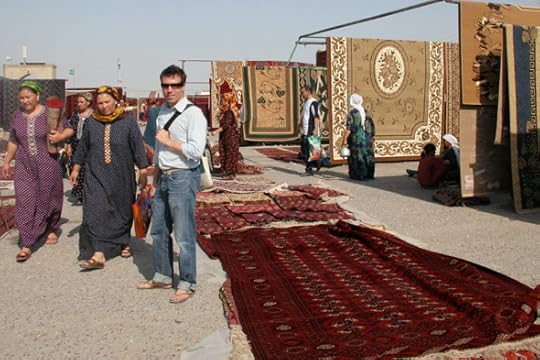Eric Enno Tamm's Blog: Eric Enno Tamm, page 3
October 20, 2010
"A magnificently provocative book" – Georgia Straight
Reviewed by Alexander Varty, Georgia Straight, October 19, 2010
Once one of the world's forgotten trade routes, the Silk Road has recently become so popular that there are more would-be travel journalists trekking the old camel trail than there are tractor trailers on the Coquihalla (way too many, in other words).
Ottawa-based Eric Enno Tamm, however, has taken a relatively untrodden path across the sands of the Gobi and from there into the heart of China, and that has a lot to do with his travelling companion: the ghostly shade of Baron Gustaf Mannerheim. Aristocrat, horseman, architect of modern Finland, military strategist, and—in the years between 1906 and 1908—spy for the Russian emperor Nicholas II, Mannerheim seems a figure out of some Ruritanian adventure novel, but proves a wise and prescient guide for a lone Canadian abroad.
Tamm's book—named for Mannerheim's romanticized translation of his Chinese moniker, Ma Dahan—has a tripartite agenda. It's a telling of the Finnish hero's "lost" years, during which he travelled Central Asia posing as an ethnologist, recording the tribal customs of the Turkmen, Uigurs, and Uzbeks. It's a record of Tamm's own Asian journey, which began 100 years to the day after the baron set out on the road. And it's an attempt to survey the booming enigma that is present-day China, with special attention paid to the consequences for its citizens, the local environment, and the global economy.
A successful attempt, I should stress, although it's not always pleasant reading. The baron's China, although desolate and poverty-stricken, still retained touches of its former glamour, with its scholar-poet administrators, ancient ceremonies, and formal gardens. The China Tamm encounters a century later is a throbbing hive of smog and corruption and, yes, wealth, although not much of that trickles down to the $2,000-a-year workers he finds staring into their computers at a Xi'an data mill.
That's a scene the baron never could have envisioned, although Mannerheim did beat contemporary reporters to the punch when discussing the role that coal would play in fuelling China's economic revival, the controversial policy of flooding "ethnic" areas with Han settlers (already under way in Mongolia a century ago, as it is in Tibet today), and the infrastructural stresses that, then as now, are cause for serious worry over the country's future. He was a brilliant man, and this is a magnificently provocative book.
October 15, 2010
Liu Xiaobo's Nobel Prize and imprisonment sparks call for political reform
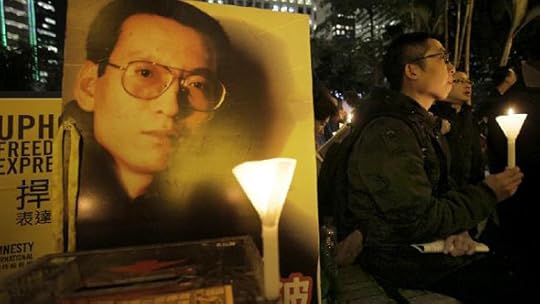
A candlelight vigil for imprisoned human rights activist and Nobel Prize winner Liu Xiaobo.
Some 120 prominent activists and scholars have penned a letter calling for political reform and supporting Nobel Peace prize winner Liu Xiaobo. This comes on the heels of an earlier letter by 23 Communist Party elders calling for Beijing to lift censorship which stifles and warps civil society in China.
"We call upon the Chinese authorities to make good on their oft-repeated promise to reform the political system," reads the letter, which is being circulated online.
"In a recent series of speeches," it goes on, "Premier Wen Jiabao has intimated a strong desire to promote political reform. We are ready to engage actively in such an effort. We expect our government to uphold the constitution of The People's Republic of China as well as the Charter of the United Nations and other international agreements to which it has subscribed."
The letter, signed by more than 100 professors, writers, lawyers and human rights activists, calls for the release of the imprisoned Mr. Liu, who won the prestigious Nobel Peace prize.
"This is a major event in modern Chinese history. It offers the prospect of a significant new advance for Chinese society in its peaceful transition toward democracy and constitutional government," the letter states.
One of the letter's signatories is Xu Youyu, a prominent liberal philosopher and scholar at the Chinese Academy of Social Sciences. Xu also signed Charter 08, the treatise authored by Liu Xiaobo calling for the end of one-party rule, democracy and widespread political reform.
I interviewed Xu in his Beijing apartment in 2007 just prior to the publication of Charter 08. His interview and conversations with other activists and historians make up my book's last chapter, which compares political reform in the late Qing Dynasty to Communist China today. The parallels are striking.
Born at the start of the Communist Revolution, Xu graduated middle school and quickly became a fanatical Red Guard in Mao's Cultural Revolution. He moved to the countryside for several years before working in a factory. He began university, at age thirty-one, in 1978, the year Deng Xiaoping launched his modernization program. He has been a visiting scholar at Oxford, Harvard and Stanford, and is China's leading proponent of John Rawls, an American philosopher whose theory of justice balances freedom with equality of opportunity.
"In China, the problem is very simple," Xu told me. "Almost every single rich person has earned their income illegally." Wealth is entirely determined by the power of guanxi. Corruption is endemic. "Almost everyone in China recognizes that political reform is necessary," he explained. "If political reform is not carried out, continued economic reform won't happen. But political reform is just empty words from the authorities."
About two years after my visit, Xu and some three hundred activists, lawyers and academics signed Charter 08, a manifesto calling for constitutional democracy and the rule of law in China. As one of the highest profile signatories, Xu has been interrogated and harassed by police, and has defied demands to withdraw his signature. Some senior Party officials consider Charter 08 a movement to overthrow the Communist government. "Such an interpretation of the Charter and the allegations of criminality are absurd," Xu told a London newspaper, "but that is not new in China."
Charter 08 states that the Communist Party's "approach to 'modernization' has proven disastrous. It has stripped people of their rights, destroyed their dignity, and corrupted normal human intercourse." What little political reform there has been in China has "extended no further than the paper on which it is written." The Charter goes on:
The stultifying results are endemic official corruption, an undermining of the rule of law, weak human rights, decay in public ethics, crony capitalism, growing inequality between the wealthy and the poor, pillage of the natural environment as well as of the human and historical environments, and the exacerbation of a long list of social conflicts, especially, in recent times, a sharpening animosity between officials and ordinary people.
As these conflicts and crises grow ever more intense, and as the ruling elite continues with impunity to crush and to strip away the rights of citizens to freedom, to property, and to the pursuit of happiness, we see the powerless in our society—the vulnerable groups, the people who have been suppressed and monitored, who have suffered cruelty and even torture, and who have had no adequate avenues for their protests, no courts to hear their pleas—becoming more militant and raising the possibility of a violent conflict of disastrous proportions. The decline of the current system has reached the point where change is no longer optional.
The Charter's signatories call for sweeping political reform: a new constitution, the separation of powers, legislative democracy, an independent judiciary, greater freedoms, protection of human rights and private property, and much more.
The outrage and attacks against China's ruling regime—and the call for genuine political reform—echo similar demands in the dying days of the Qing Dynasty, a point I underscore in my book. The timing of the manifesto wasn't lost on its authors either. Charter 08's opening line reads: "A hundred years have passed since the writing of China's first constitution."
October 13, 2010
Google Earth map of old and new Kashgar
Starting in 2006, the Canadian Eric Enno Tamm retraced the steps of an expedition undertaken exactly 100 years earlier by the Finnish soldier and spy Gustaf Mannerheim, from Russia to Peking via the Silk Road. The result of Tamm's trek is a newly released book, part travelogue and part history, that examines how China has (and hasn't) changed in the intervening century. It's called The Horse That Leaps Through Clouds.
I can't wait to get my hands on a copy, because Tamm wrote a chapter about Kashgar, my favorite disappearing city. On the book's website there is a web page about the chapter, which shows an intriguing map — a sketch map depicting Kashgar in 1908, as drawn by a Brit, a certain Captain A.R.B. Shuttleworth stationed at the British Consulate there.
Tamm had a go overlaying the map on Google Earth, but it seemed to me like a better fit was possible, so I asked him for the original scan of the map, which he had found in the British Library in London. He graciously sent it over.
The result is this KMZ Google Earth file (full resolution, 2.7MB), which shows the map both in its original form and as a inverse transparency:
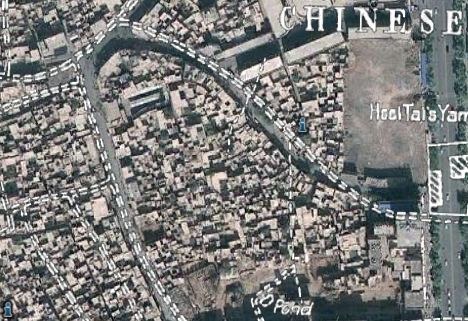
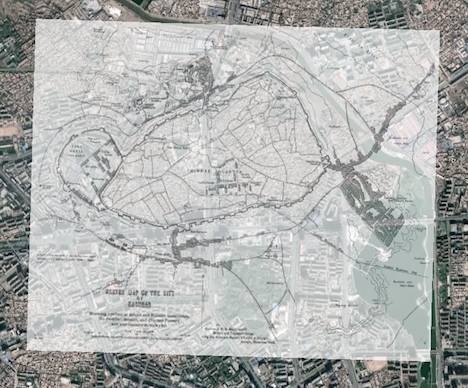
It's clear from trying to position the map that in places it is not topographically accurate. But by anchoring the North, South and East gates to their modern-day locations, a good number of landmarks match, including large parts of the city wall. Right away, it also becomes clear that the river's course used to lie further East, across lowlands that are now decked in relatively modern buildings. The maps's main discrepancy can be found in the size and orientation of the settlement to the Southeast of the city; the fortress to the west is also larger than life. In the Eastern half of the cities, the topology of the mapped alleys is tantalizingly familiar, though without producing accurate matches.
The overlay makes a great companion to the KMZ Google Earth file produced from the week I spent in Kashgar this past summer documenting the ongoing demolition of most of the old city. With this "new" old map, it's even clearer how much of the destruction is going on inside the circumference of the old city walls.
(As always, play with the transparency slider to get the most out of the various layers in the Google Earth files linked to above.)
Letter: On Liu Xiaobo and the Nobel Peace Prize – 关于刘晓波获得诺贝尔和平奖的声明
The awarding of the 2010 Nobel Peace Prize to Liu Xiaobo, a Chinese citizen, has drawn strong reactions both inside and outside China. This is a major event in modern Chinese history. It offers the prospect of a significant new advance for Chinese society in its peaceful transition toward democracy and constitutional government. In a spirit of responsibility toward China's history and the promise in its future, we the undersigned wish to make these points:
1. The decision of the Nobel Committee to award this year's prize to Liu Xiaobo is in full conformity with the principles of the prize and the criteria for its bestowal. In today's world, peace is closely connected with human rights. Deprivation and devastation of life happens not only on battlefields in wars between nations; it also happens within single nations when tyrannical governments employ violence and abuse law. The praise that we have seen from around the world for the decision to award this year's prize to a representative of China's human rights movement shows what a wise and timely decision it was.
2. Liu Xiaobo is a splendid choice for the Nobel Peace Prize. He has consistently advocated non-violence in his quest to protect human rights and has confronted social injustice by arguing from reason. He has persevered in pursuing the goals of democracy and constitutional government and has set aside anger even toward those who persecute him. These virtues put his qualifications for the prize beyond doubt, and his actions and convictions can, in addition, serve as models for others in how to resolve political and social conflict.
3. In the days since the announcement of his prize, leaders in many nations, regions, and major world organizations have called upon the Chinese authorities to release Liu Xiaobo. We agree. At the same time we call upon the authorities to release all political prisoners and prisoners of conscience who are in detention for reasons such as their speech, their political views, or their religious beliefs. We ask that legal procedures aimed at freeing Liu Xiaobo be undertaken without delay, and that Liu and his wife be permitted to travel to Oslo to accept the Nobel Peace Prize.
4. Upon hearing the news of Liu Xiaobo's prize, citizens at several locations in China gathered at restaurants to share their excitement over food and wine and to hold discussions, display banners, and distribute notices. Normal and healthy as these activities were, they met with harassment and repression from police. Some of the participants were interrogated, threatened, and escorted home; others were detained; still others, including Liu Xiaobo's wife Liu Xia, have been placed under house arrest and held incommunicado. We call upon the police to cease these illegal actions forthwith and to immediately release the people who have been illegally detained.
5. We call upon the Chinese authorities to approach Liu Xiaobo's Nobel Prize with realism and reason. They should take note of the responses to the prize inside and outside China and see in these responses the currents in world thinking as well as the underlying preferences of our fellow citizens. China should join the mainstream of civilized humanity by embracing universal values. Such is the only route to becoming a "great nation" that is capable of playing a positive and responsible role on the world stage. We are convinced that any signs of improvement or goodwill from the government and its leaders will be met with understanding and support from the Chinese people and will be effective in moving Chinese society in a peaceful direction.
6. We call upon the Chinese authorities to make good on their oft-repeated promise to reform the political system. In a recent series of speeches, Premier Wen Jiabao has intimated a strong desire to promote political reform. We are ready to engage actively in such an effort. We expect our government to uphold the constitution of The People's Republic of China as well as the Charter of the United Nations and other international agreements to which it has subscribed. This will require it to guarantee the rights of Chinese citizens as they work to bring about peaceful transition toward a society that will be, in fact and not just in name, a democracy and a nation of laws.
October 2, 2010
Demolishing Kashgar, repressing Uyghurs
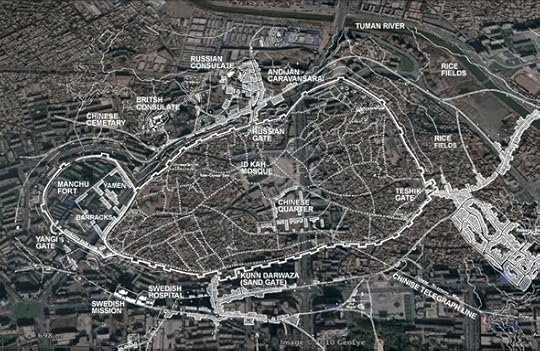
A British military survey map of Old Kashgar from 1908 superimposed over a satellite view of the modern city.
In an eerie way, Kashgar reminds me of Paris. While researching my book, I visited the Uyghur oasis in China's western region of Xinjiang and saw it undergoing a massive demolition. The reason: Chinese officials say the town's old neighbourhoods are unsafe and vulnerable to earthquakes. The solution: raze the ancient quarter and reconstruct a new city.
Almost every Muslim town in Xinjiang that I visited is being modernized along the exact same lines: medieval walls, narrow bazaar streets and labyrinths of low-slung courtyard homes are being bulldozed to make way for a network of grand boulevards, modern apartments, shops and monumental public spaces. (Check out my cool map of Old and New Kashgar). It is a scheme pioneered and made famous in Paris by Georges-Eugène Haussmann. In 1852, the civic planner modernized the French capital by demolishing entire blocks and laying out a spectacular axial grid over Paris.
According to Xu Jianrong, Kashgar's deputy mayor, the modernization is supposed to improve residents' standard of living, yet authoritarianism, as in Haussmann's Paris, underlies China's new urbanism. Haussmann designed boulevards so infantry could easily circulate and control the city, and fire artillery at unruly citizenry if need be. The French brought this scheme to their own colonial outposts, ploughing grandiose boulevards through the ancient Muslim quarters of Algiers and Tunis.
Chinese city planners are now effectively doing the same: destroying the warren of Muslim homes and shops where Uyghur dissidents and nationalists can hid. By relocating Uyghurs to mid-rise apartments, Beijing can better control and contain its often unruly Muslim citizens. Kashgar is even crowned with a monument to modernity: a steel telecommunications tower atop the Public Security Bureau in the centre of town pierces the skyline like a miniature Eiffel Tower.
No one should be surprised by this politically motivated destruction. Chinese authorities have admitted as much. The Uyghur neighbourhood of Heijiashan in Urumiqi was home to 200,000 people. It was knocked down and is to be replaced by a new residential development. The official Xinhua news agency described the area as a "hotbed of poverty and crime" that "disrupted social order." Heijiashan was a flashpoint for ethnic violence that erupted on July 5, 2009 in Urumqi between Uyghurs and the majority Han Chinese, leaving nearly 200 dead and 1,700 injured.
Al Jazeera English has done a half-hour documentary on Kashgar, its destruction and China's repressive rule in Xinjiang. It is a fascinating and vivid portrait of the city with spectacular cinematography. It is well worth watching. I've posted the videos below.
AL JAZEERA ENGLISH: China's Uighur dilemma
"His journey has tremendous scope and panache… serious, generous and enlightening"
I began reading The Horse That Leaps Through Clouds mindful of Pankaj Mishra's recent comment that "the societies I travelled through are too internally diverse to be summed up by broad generalizations of the kind preferred by policy-makers and op-ed columnists." The premise of Eric Enno Tamm's book, subtitled A Tale of Espionage, the Silk Road and the Rise of Modern China, invited similar skepticism but won me over on nearly every page.
Tamm, a writer in Ottawa, followed the route of the late-19th-century Finno-Russian diplomat, military officer and spy Baron Gustaf Mannerheim across Russia and its eastern reaches, Xinjiang and Gansu provinces, Tibet, Xian, Inner Mongolia and, finally, metropolitan Beijing — more than 15,000 kilometres.
He attempts to answer a question that in less able hands would be vacuous: Are we looking at an inevitable collapse reminiscent of the Qing Dynasty's or a transformation unrealized by the wave of change and reform in the early 1900s?
This route had already been traversed, in various ways, by some great writers. What had Tamm to tell us that Colin Thubron (Shadow of the Silk Road, 2006) and Ma Jian ( Red Dust: A Path Through China, 2004) had not?
A great deal, as it turns out. Tamm's account of his journey has tremendous scope and panache. He unearths what has happened to these regions in the intervening 100 years and his ghost companion, Mannerheim, proves useful as a baseline from which to gauge the changes…
Wisely, Tamm doesn't answer his initial question. By the end, his travels have worn him down to an awed humility, and he echoes an earlier British observer to the effect that the longer you stay in China, the less you know.
He writes: "Yet after my trek through its far reaches, I did not fear China but grew to fear for China. . . . Many of [its] problems are interconnected so that a crisis in one area could spill over into others, potentially leading to a widespread social breakdown."
In short, The Horse That Leaps Though Clouds is a serious, generous and enlightening introduction to this huge and infrequently travelled part of the world…
September 30, 2010
In a spy's footsteps, "relentless curiousity takes over"
Author Eric Enno Tamm in the carpet market in Ashgabat, the capital of Turkmenistan.
Reviewed by James Macgowan, The Ottawa Citizen, September 29, 2010
If I were a completely different person — one with guts, determination and a zest for life — I wouldn't have any need to read Eric Enno Tamm's fascinating and exhausting-by-proxy new book, The Horse That Leaps Through Clouds. I would make the 17,000-kilometre journey from St. Petersburg to Beijing myself.
But that's the great thing about travel/historical books such as this. While the writer's getting, say, heat stroke, armchair travellers who lack guts, determination and a zest for life can get up at the slightest hint of personal discomfort, find a cool, refreshing drink and then return to the journey at hand feeling none the worse for wear.
In this case, it's two journeys: Tamm's and Finnish icon Baron Carl Gustaf Mannerheim's, the latter having made the same trip, more or less, in 1906. He is, in effect, Tamm's travelling companion. "By reading his journal and following in his footsteps, I hoped to share common experiences and perhaps bond with the Baron," Tamm writes. Each night, he turns to Mannheim's journal for "context and comfort" as well as "hints of what lay ahead on the road and, perhaps, in China's future."
Though born in Tofino, B.C., and currently living in Ottawa, Tamm is of Estonian descent. He grew up listening to his father tell Second World War stories, many of them involving Mannerheim, who was then the commander-in-chief of the Finnish army. (Finland and Estonia are very close, both culturally and geographically.) These stories piqued Tamm's interest, but it wasn't until 2000 that he first heard about Mannerheim's Asian journey and started thinking about retracing it. It would prove to be a daunting task.
September 23, 2010
Inner Mongolia's Vanishing Grasslands
September 10, 2010
Death by a thousand cranes
September 7, 2010
Panoramic views of Old Kashgar
Id Kah Great Mosque (Kashgar City) in Xinjiang
fragrant imperial concubine grave(Kashi) in Xinjiang
Kashgar – the high-profile residential areas-2 in Xinjiang

